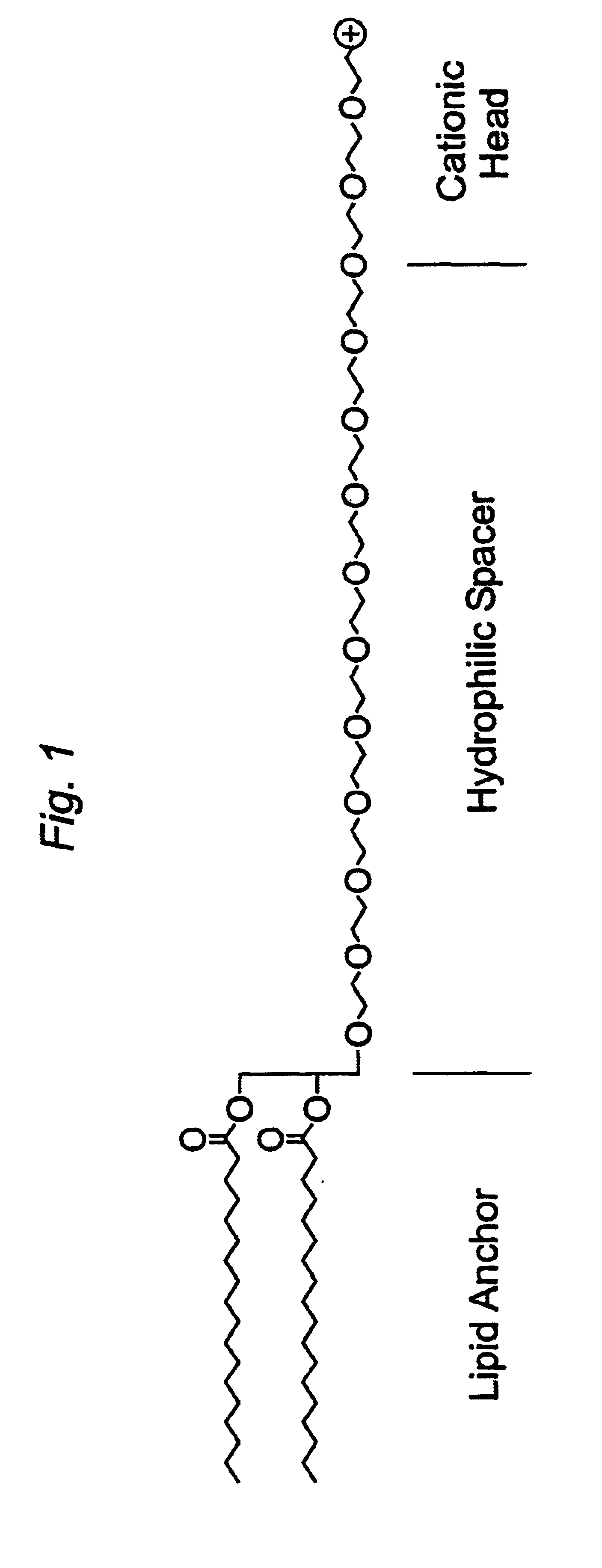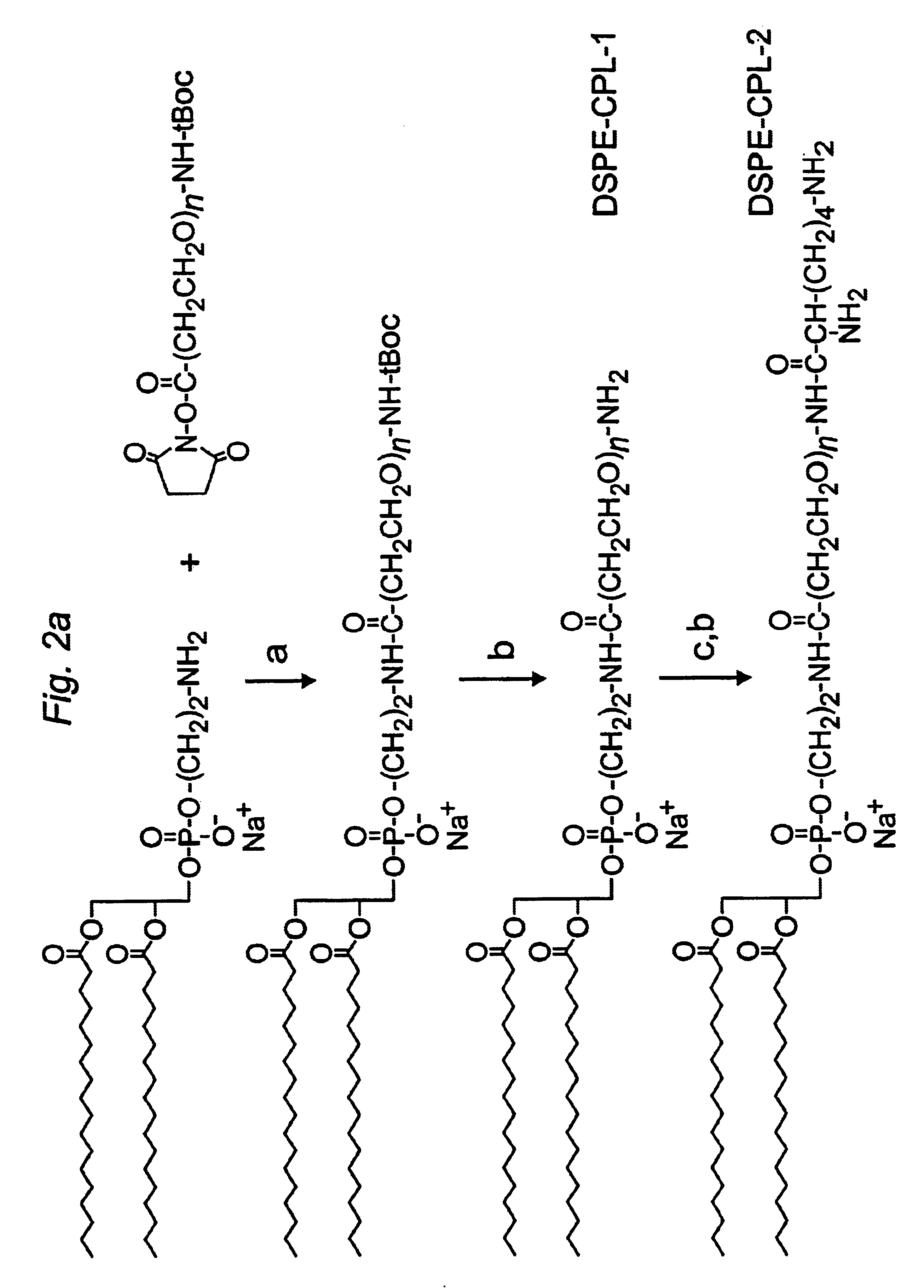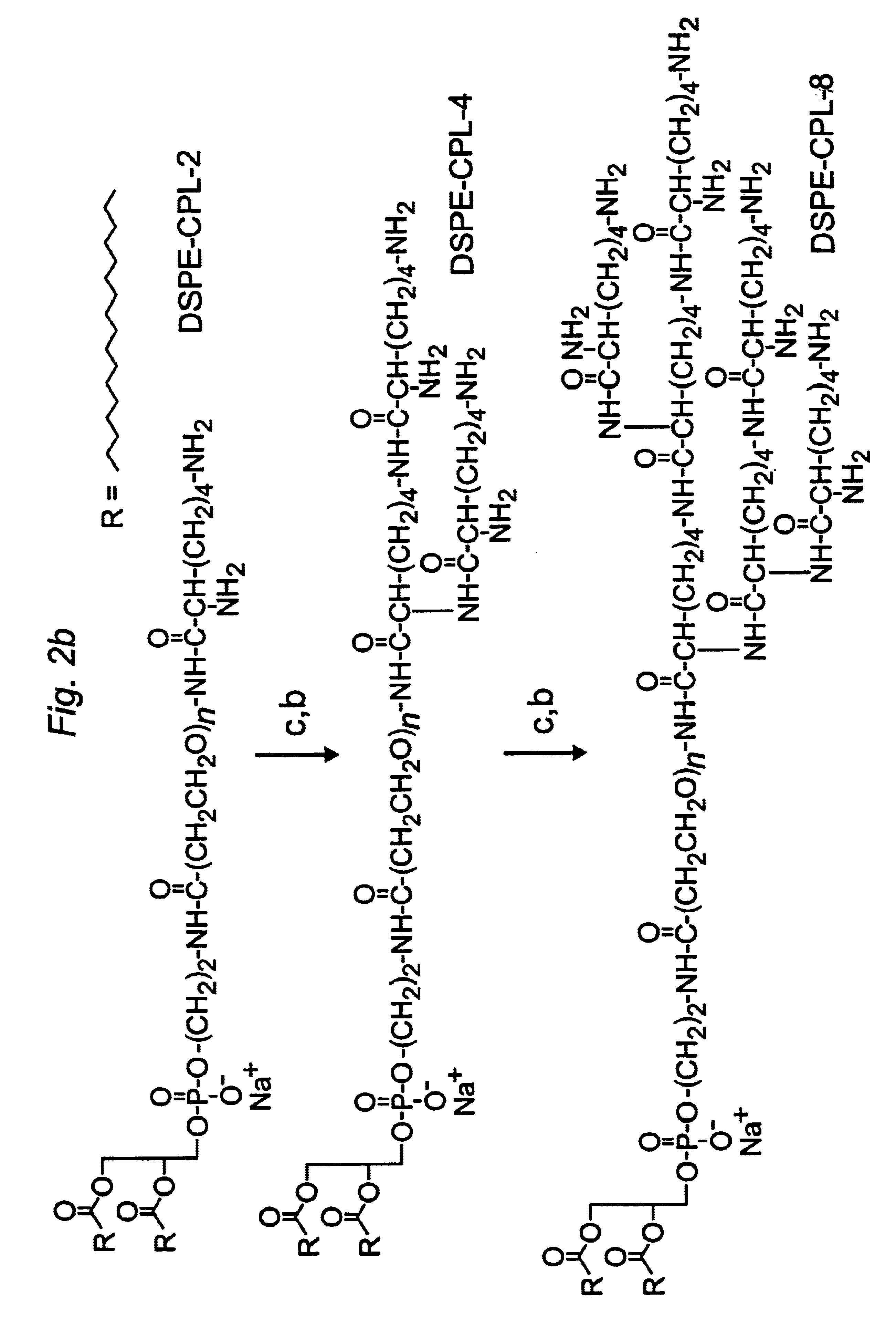Cationic peg-lipids and methods of use
a technology of lipids and pegs, applied in the field of cationic lipid conjugates, can solve the problems of limiting the application of these complexes, toxicity and instability of complexes in serum, and reducing the efficiency of liposomes, so as to improve the efficiency of transfection
- Summary
- Abstract
- Description
- Claims
- Application Information
AI Technical Summary
Benefits of technology
Problems solved by technology
Method used
Image
Examples
example i
I. Example I
A. General Overview
Distal cationic-poly(ethylene glycol)-lipid conjugates (CPL) were designed, synthesized and incorporated into conventional and stealth liposomes for enhancing cellular uptake. The present approach uses either inert, nontoxic or naturally occurred compounds as components for the CPL synthesis. CPLs were synthesized with the following architectural features: 1) a hydrophobic lipid anchor of DSPE for incorporating CPLs into liposomal bilayer; 2) a hydrophilic spacer of polyethylene glycol for linking the lipid anchor to the cationic head group; and 3) a naturally occurring amino acid (L-lysine) was used to produce a protonizable cationic head group. The number of charged amino groups can be controlled during the CPL synthesis. It has been demonstrated that DSPE-CPLs were almost quantitatively incorporated into liposomal bilayer by a hydration-extrusion method. Quite surprisingly, in an in vitro model, it was confirmed for the first time that liposomes pos...
example ii
II. Example II
This example illustrates that LUVs containing CPL4 can be formed by a detergent dialysis method.
The LUVs contain DOPE, DODAC, PEG-Cer-C20, and CPL4[3.4K] (or CPL4[1K]). Two preparations were made with the CPL comprising 4 mol % of the original lipids:
TABLE 4Lipidmol-%DODAC6DOPE79.5CPL44PC-C2010Rho-PE0.5
The lipids indicated above were co-dissolved in chloroform, which was then removed under nitrogen followed by 2 hours under high vacuum. The dry lipid mixture (10 μmol total) was then hydrated in 83 μL of 1 M OGP and 1 mL Hepes-buffered saline (20 mM Hepes 150 mM NaCl pH 7.5) at 60° C. with vortexing until all the lipid was dissolved in the detergent solution.
The lipid-detergent mixture was transferred to Slide-A-Lyzer dialysis cassettes, and dialysed against at least 2 L HBS for 48 hours, with a least two changes of buffer in that time. Removal of detergent by dialysis results in formation of LUVs. To determine whether all of the CPL was incorporated into the LUVs follo...
example iii
III. Example III
A. Overview
In this example, a non-specific targeting approach is described that involves increasing the electrostatic attraction between liposomes and cells by incorporation of positively-charged lipid molecules into preformed vesicles. This approach leads to dramatic increases in cell binding / uptake in vitro in BHK cells. The methodology is demonstrated to work for neutral vesicles and for vesicles composed of lipids used in the construct of lipid-based gene carriers. The approach outlined herein thus has numerous applications ranging from delivery of conventional drugs to gene therapy.
B. Materials and Methods
1. Materials: 1,2-dioleoylphosphatidylcholine (DOPC), 1,2-dioleoylphosphatidylethanolamine (DOPE), and 1,2-dioleoyl-sn-glycero-3-phosphoethanolamine-N-(Lissamine Rhodamine B Sulfonyl) (Rhodamine-PE) were obtained from Avanti Polar Lipids. Cholesterol was obtained from Sigma Chemical Co. DODAC and PEGCerC20, PEGCerC14, and PEGCerC8 were generous gifts from Inex ...
PUM
| Property | Measurement | Unit |
|---|---|---|
| molecular weight | aaaaa | aaaaa |
| size | aaaaa | aaaaa |
| molecular weight | aaaaa | aaaaa |
Abstract
Description
Claims
Application Information
 Login to View More
Login to View More - R&D
- Intellectual Property
- Life Sciences
- Materials
- Tech Scout
- Unparalleled Data Quality
- Higher Quality Content
- 60% Fewer Hallucinations
Browse by: Latest US Patents, China's latest patents, Technical Efficacy Thesaurus, Application Domain, Technology Topic, Popular Technical Reports.
© 2025 PatSnap. All rights reserved.Legal|Privacy policy|Modern Slavery Act Transparency Statement|Sitemap|About US| Contact US: help@patsnap.com



